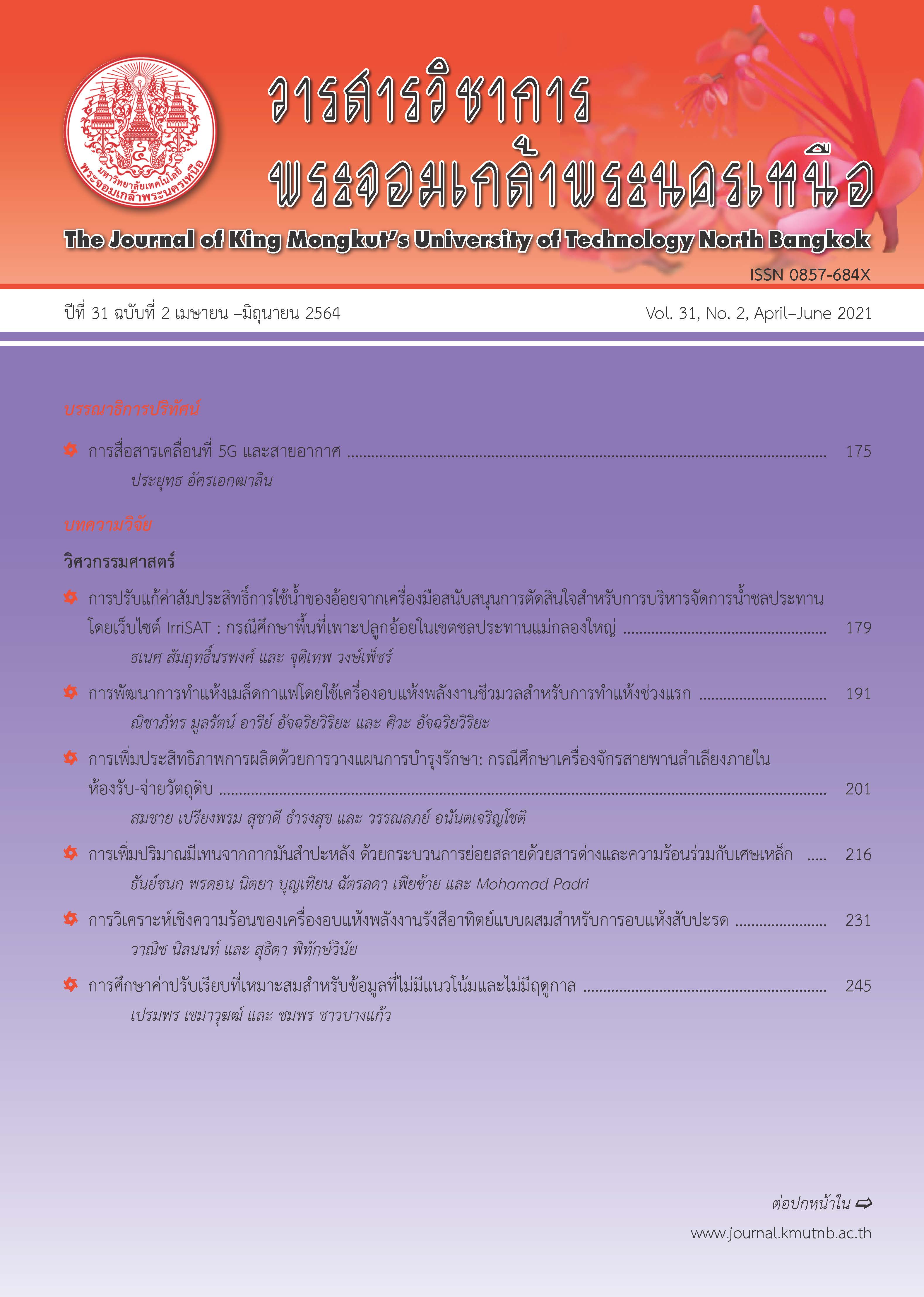ผลของรำข้าวไรซ์เบอร์รี่ต่อการพัฒนาผลิตภัณฑ์โยเกิร์ตนมแพะพร้อมดื่มเชิงหน้าที่
Main Article Content
บทคัดย่อ
ศึกษาการใช้ประโยชน์จากรำข้าวไรซ์เบอร์รี่ในการพัฒนาโยเกิร์ตนมแพะพร้อมดื่มเชิงหน้าที่ โดยเสริมรำข้าวไรซ์เบอร์รี่เป็นสารเชิงหน้าที่ในโยเกิร์ตพร้อมดื่มเพื่อปรับปรุงประโยชน์ต่อสุขภาพ โยเกิร์ตพร้อมดื่มสี่สูตรเตรียมจากนมแพะเสริมด้วยรำข้าวไรซ์เบอร์รี่ 0, 1, 2 และ 3% (w/v) ซึ่งในระหว่างการเก็บรักษานาน 8 วัน ที่อุณหภูมิ 4 องศาเซลเซียส พบว่า ปริมาณของแข็งที่ละลายได้ทั้งหมด ค่าความเป็นกรด-ด่าง ปริมาณกรดที่ไตเตรทได้ จำนวนแบคทีเรียกรดแลคติก และจำนวนยีสต์และราเปลี่ยนแปลงอย่างไม่มีนัยสำคัญทางสถิติเมื่อเสริมรำข้าวไรซ์เบอร์รี่ (p ≥ 0.05) โยเกิร์ตนมแพะพร้อมดื่มทุกสูตรมีจำนวนแบคทีเรียกรดแลคติกที่มีชีวิตในปริมาณสูง (> 8 log cfu/mL) ระหว่างการเก็บรักษา กิจกรรมการต้านอนุมูลอิสระ DPPH ของโยเกิร์ตนมแพะพร้อมดื่มเพิ่มขึ้นเมื่อเติมรำข้าวไรซ์เบอร์รี่ (p < 0.05) อย่างไรก็ตาม การยอมรับทางประสาทสัมผัสลดลงเมื่อเติมรำข้าวไรซ์เบอร์รี่ (p < 0.05)
Article Details
บทความที่ลงตีพิมพ์เป็นข้อคิดเห็นของผู้เขียนเท่านั้น
ผู้เขียนจะต้องเป็นผู้รับผิดชอบต่อผลทางกฎหมายใดๆ ที่อาจเกิดขึ้นจากบทความนั้น
เอกสารอ้างอิง
[2] G. Getaneh, A. Mebrat, A. Wubie, and H. Kendie, “Review on goat milk composition and its nutritive value,” Journal of Nutrition and Health Sciences, vol. 3, no. 4, pp. 401–410, 2016.
[3] S. D. Kalyankar, C. D. Khedkar, and A. M. Patil, “Goat milk,” in The Encyclopedia of Food and Health, London: Elsevier Publishers, 2016, pp. 256–260.
[4] F. Guarner, G. Perdigon, G. Corthier, S. Salminen, B. Koletzko, and L. Morelli, “Should yoghurt cultures be considered probiotic?,” British Journal of Nutrition, vol. 93, no. 6, pp. 783–786, 2055.
[5] R. C. Ray and D. Montet, Microorganisms and Fermentation of Traditional Foods. Boca Raton, FL : CRC Press, 2015.
[6] World Health Organization. (2005). The treatment of diarrhoea: A manual for physicians and other senior health workers, 4th rev. World Health Organization Available: https://apps.who.int/ iris/handle/10665/43209
[7] T. Demirci, K. Aktas, D. Sozeri, H. I. Ozturk, and N. Akin, “Rice bran improve probiotic viability in yoghurt and provide added antioxidantive benefits,” Journal of Functional Foods, vol. 36, pp. 396–403, 2017.
[8] A. M. S. Hussien, H. M. Abbas, H. M. Bayoumi, and M. A. El-Aziz, “Properties of full fat bran and yogurt fortified with it,” International Journal of Dairy Science, vol. 12, no. 3, pp. 170– 176, 2017.
[9] M. Karaaslan, M. Ozden, H. Vardin, and H. Turkoglu, “Phenolic fortification of yogurt using grape and callus extracts,” LWT-Food Science and Technology, vol. 44, no. 4, pp. 1065–1072, 2011.
[10] H. Ham, S. W. Yoon, I. Kim, J. Kwak, J. Lee, H. Jeong, and J. Lee, “Protective effects of unsaponifiable matter from rice bran on oxidative damage by modulating antioxidant enzyme activities in HepG2 cells,” LWT-Food Science and Technology, vol. 61, no. 2, pp. 602–608, 2015.
[11] N. M. N. Prasad, K. R. Sanjay, S. M. Khatokar, M. N. Vismaya, and N. S. Swamy, “Health benefits of rice bran-A review,” Journal of Nutrition and Food Science, vol. 1, no. 3, pp. 1–8, 2011.
[12] M. Peanparkdee, R. Yamauchi, and S. Iwamoto, “Characterization of antioxidant extracted from Thai Riceberry bran using ultrasonic-assisted and conventional solvent extraction methods,” Food and Bioprocess Technology, vol. 11, pp. 713– 722, 2018.
[13] P. Suttiarporn, P. Sookwong, and S. Mahatheeranont, “Fractionation and identification of antioxidant compounds from bran of Thai black rice cv. Riceberry,” International Journal of Chemical Engineering and Application, vol. 7, no. 2, pp. 109–114, 2016.
[14] W. H. Ling, L. L. Wang, and J. Ma, “Supplementation of the black rice outer layer fraction to rabbits decreases atherosclerotic plaque formation and increases antioxidant status,” Journal of Nutrition, vol. 132, no. 1, pp. 20–26, 2002.
[15] P. Kurdi and C. Hansawasdi, “Assessment of the prebiotic potential of oligosaccharide mixtures from rice bran and cassava pulp,” LWT-Food Science and Technology, vol. 63, no. 2, pp. 1288– 1293, 2015.
[16] S. El-Shibiny, M. A. M. Abd El-Gawad, F. M. Assem, F. L. Seleet, S. A. Abou Dawood, and M. Elaaser, “Preparation, composition and microbiological and rheological properties of functional processed cheese supplemented with rice bran,” Journal of Applied Sciences Research, vol. 9, no. 8, pp. 4927–4934, 2013.
[17] T. A. D. G. Machada, M. E. G. D. Oliveira, M. I. F. Campos, P. O. A. D. Assis, E. J. D. Souza, S. Madruga, M. T. B. Pacheco, M. M. E. Pintada, and R. D. R. D. E. Queiroga, “Impact of honey on quality characteristics of goat yogurt containing probiotic Lactobacillus acidophilus,” LWT-Food Science and Technology, vol. 80, pp. 221–229, 2017.
[18] A. Chaikulsareewath, “Production of drinking yogurt fortified with gac fruit,” Journal of Food Technology Siam University, vol. 7, no. 1, pp. 23–30, 2012 (in Thai).
[19] A. S. Gad and S. H. S. Mohamad, “Effect of hydrocolloid type on physiochemical properties of nonfat drinkable yogurt fermented with ropy and non-ropy yogurt cultures,” Comunicata Science, vol. 5, no. 3, pp. 318–325, 2014.
[20] A.O.A.C, Official Methods of Analysis, 19th ed. Gaithersburg: Association of Official Analytical Chemist, 2005.
[21] M. Ye, L. Ren, Y. Wu, Y. Wang, and Y. Liu, “Quality characterisitcs and antioxidant activity of hickory-black soybean yogurt,” LWT-Food Science and Technology, vol. 51, no. 1, pp. 314– 318, 2013.
[22] A. E. Yousef and C. Carlstrom, Food Microbiology: A Laboratory Manual. New Jersey: John Wiley and Sons, 2003.
[23] C. S. Ranadheera, C. A. Evans, M. C. Adams, and S. K. Baines, “Probiotic viability and physicchemical and sensory properties of plain and stirred fruit yogurts made from goat’s milk,” Food Chemistry, vol. 135, no. 3, pp. 1411–1418, 2012.
[24] A. Moongngarm, N. Daomukda, and S. Khumpika, “Chemical compositions, phytochemicals, and antioxidant capacity of rice bran, rice bran layer, and rice germ,” APCBEE Procedia, vol. 2, pp. 73–79, 2012.
[25] C. S. Ranadheera, C. A. Evans, M. Adams, and S. K. Baines, “Co-culturing of probiotics influences the microbial and physio-chemical properties but not sensory quality of fermented dairy drink made from goats’ milk,” Small Ruminant Research, vol. 136, pp. 104–108, 2016.
[26] Codex Alimentarius. (2018). Codex standard for fermented milks. Codex Alimentarius [Online]. Available: http://www.fao.org/faowho- codexalimentarius/en/
[27] I. S. Surono and A. Hosono, “Fermented milks,” Encyclopedia of Dairy Sciences, vol. 2, pp. 470– 476, 2011.
[28] M. B. Guler-Akin, I. Ferliarslan, and M. S. Akin, “Apricot probiotic drinking yoghurt supplied with inulin and oact fiber,” Biomedical & Life Sciences, vol. 6, no. 14, pp. 999–1009, 2016.
[29] Ministry of Public Health. (2013, July). Notification of the ministry of public health (No. 353) B.E. 2556 RE: fermented milk. Ministry of Public Health. Bangkok, Thailand. [Online]. Available: http://extwprlegs1.fao.org/docs/pdf/ tha159846.pdf

